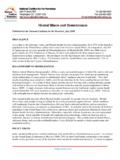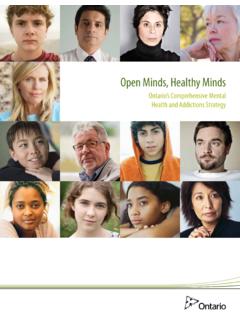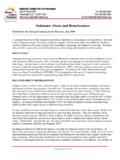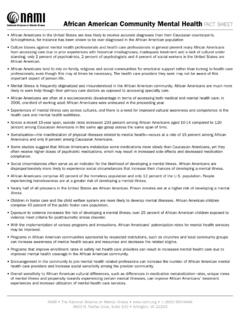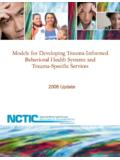Transcription of All Our Children: Strategies to Prevent …
1 NYC COMMISSION ON LESBIAN, GAY, BISEXUAL, TRANSGENDER AND QUESTIONING RUNAWAY AND HOMELESS YOUTHANA L. OLIVEIRA, CHAIR JEANNE B. MULLGRAV, DIRECTOR All Our Children: Strategies to Prevent Homelessness, Strengthen Services and Build Support for LGBTQ YouthLETTER TO THE MAYORJune 2010 Dear Mayor Bloomberg:We are pleased to present the final report of the Commission on Lesbian, Gay, Bisexual, Transgender and Questioning (LGBTQ) Runaway and Homeless Youth. As you recognized in creating the Commission, addressing the complex needs of LGBTQ youth requires a coordinated agenda. Since you announced the Commission on October 5, 2009, the members have undertaken extensive research and analysis and received critical input from many stakeholders, including national experts and youth with first-hand experience of homelessness.
2 While the Commission s findings confirm that LGBTQ homeless youth face special challenges, we strongly believe that the recommendations and Strategies set out in the report offer actionable steps to promote best practices, foster a culture of respect and acceptance, and address the underlying causes of homelessness among LGBTQ members of the Commission are immensely grateful to you for the unprecedented opportunity to work together to help New York City lead the nation in improving the lives of this vulnerable group of young people. Ana L. Oliveira Commissioner Jeanne B. Mullgrav Chair DirectorACKNOWLEDGMENTSThe New York City Commission for Lesbian, Gay, Bisexual, Transgender and Questioning Runaway and Homeless Youth would like to gratefully acknowledge the City agencies, individuals and organizations whose assistance and expertise informed the work of this City agencies and the public libraries contributed to the work of the Commission, including, in particular, the New York City Administration for Children s Services, the Department of Health and Mental Hygiene, the Department of Homeless Services, the New York Police Department, the Department of Cultural Affairs, the Department of Parks and Recreation.
3 And the New York City Commission on Human Rights. Alan Gartner and Bill Heinzen from the Office of the Mayor provided the Commission with valuable insights. In addition, Michael Ognibene, Susan Haskell, Lisa Gulick, Cressida Wasserman, Amy Shebar and many other DYCD staff provided vital support throughout the process. The Commission would also like to thank the experts and practitioners who shared information, data, and research findings with Commission members. Most importantly, the Commission wishes to thank all those who testified at the two Public Hearings or participated in the Listening Forums and surveys, especially, LGBTQ youth with direct experience of SUMMARYL esbian, gay, bisexual, transgender and questioning (LGBTQ) youth are disproportionately represented among New York City s homeless youth, the majority of whom are youth of color.
4 While all homeless youth may experience negative outcomes, those who identify as LGBTQ are even more vulnerable than heterosexual homeless youth due to factors such as family rejection, high rates of mental illness, and greater use of survival Strategies that increase risk for most adolescents, the key developmental task of identity formation is often difficult. For LGBTQ youth who may be rejected by parents and lack alternative supports, it can be even harder. For LGBTQ youth of color, the challenges are compounded by racism in society at large and in the predominantly white gay community. Routine stigmatization based on race and sexual identity jeopardizes the healthy development of many LGBTQ youth.
5 Historically, service providers have focused their efforts on helping youth acquire the skills needed for independent living. Parents and other family members have generally been seen as the cause of the problem, rather than part of the solution. An emerging body of research now suggests that families (or alternative support networks) have crucial roles to play in promoting the positive development of LGBTQ youth and preventing them from becoming homeless. The Commission s recommendations focus on a number of key areas and delineate a series of Strategies designed to Prevent homelessness among LGBTQ youth and young adults, and improve the effectiveness of services delivered to them. The recommendations are as follows: 1.
6 ADOPT AN INCREASED FOCUS ON FAMILIES AND DEVELOP FAMILY AND ALTERNATIVE FAMILY SUPPORT Strategies . Train providers on the importance of family acceptance Develop specific Strategies to engage family members of transgender youth Identify and disseminate resources for families of LGBTQ youth Offer activities for family and other support persons as part of programming for runaway and homeless youth Develop a range of mentoring options for youth and their parentsExecutive Summary32. TEST INNOVATIVE APPROACHES TO DEVELOP FAMILY SUPPORT FOR LGBTQ YOUTH TO Prevent HOMELESSNESS OR SHORTEN ITS DURATION. Implement pilot programs based on therapeutic models designed to build family support to help youth avoid homelessness Implement and evaluate a Host Home program model 3.
7 CREATE A BROAD SYSTEM OF SERVICES FOR LGBTQ RUNAWAY AND HOMELESS YOUTH THAT OPERATES WITHIN A POSITIVE YOUTH DEVELOPMENT FRAMEWORK AND INCORPORATES BEST PRACTICES. Promote policy and practice requirements based on best practice guidelines Integrate best practices in City agency administrative policies and procedures Create policies and protocols to ensure LGBTQ-affirming service environments and explicitly prohibit harassment and other unacceptable behaviors4. BROADEN ACCESS TO RUNAWAY AND HOMELESS YOUTH SERVICES FOR LGBTQ YOUTH. Incorporate additional outreach and drop-in center services to reach LGBTQ homeless youth who are less connected to services Advocate for changes to New York State regulations to allow providers of runaway and homeless youth programs to serve young adults ages 21 to 24 years Seek ways to expand the number of regulated shelter beds for LGBTQ homeless youth and young adults ages 16 to 24 by at least 200 over the next five years5.
8 CREATE COMPREHENSIVE AND COORDINATED HEALTH SERVICES INCORPORATING BEST PRACTICES FOR DELIVERY OF MEDICAL CARE TO LGBTQ ADOLESCENTS AND YOUNG ADULTS. Provide client-centered, coordinated health services Improve access to effective HIV/AIDS prevention and treatment services Improve health care services for transgender homeless youth6. IMPROVE ACCESS TO AND COORDINATION OF MENTAL HEALTH, SUBSTANCE ABUSE, AND TRAUMA TREATMENT SERVICES FOR LGBTQ RUNAWAY AND HOMELESS YOUTH AND YOUNG ADULTS. Adopt strong, client-centered case-management systems for mental health and related services Work to create better-coordinated services and heighten awareness of mental health issues Train providers to identify symptoms of mental health, substance abuse and trauma47.
9 IDENTIFY AND IMPLEMENT EFFECTIVE PUBLIC EDUCATION Strategies TO COMBAT HOMOPHOBIA AND TRANSPHOBIA AND PROMOTE ACCEPTANCE OF AND SUPPORT FOR LGBTQ YOUTH AND THEIR FAMILIES. Launch a public education campaign on LGBTQ issues Work with youth and providers to establish protocols for out-of-school time programs and spread awareness of LGBTQ issues8. CREATE AN LGBTQ-COMPETENT CITY WORKFORCE AND DEVELOP POLICIES AND PRACTICES THAT ARE SENSITIVE TO LGBTQ YOUTH ISSUES. Highlight LGBTQ issues as part of Equal Opportunity Training for City employees Provide ongoing, in-depth LGBTQ-competency training to frontline staff at all relevant City agencies Include measures of LGBTQ-competency in performance evaluations of frontline workers Designate the DYCD Runaway and Homeless Youth Coordinator as an LGBTQ runaway and homeless youth liaison with other City agencies9.
10 FORGE PUBLIC AND PRIVATE PARTNERSHIPS THAT INCLUDE THE ADULT LGBT COMMUNITY TO INCREASE RESOURCES AND FOSTER SUPPORT FOR THE COMMISSION S RECOMMENDATIONS. Encourage the adult LGBT community and not-for-profit providers to engage in sustained advocacy and fund-raising for LGBTQ homeless youth Explore ways to expand employment and work experience opportunities for LGBTQ homeless youth Encourage faith communities to increase support for and acceptance of LGBTQ youth and their families Reach out to the law enforcement community to explore how to improve relations with LGBTQ runaway and homeless youth and increase mutual understanding10. ENSURE ACCOUNTABILITY. Conduct periodic assessments to evaluate progress in implementing the Commission s recommendations and report findings to relevant advisory bodies and create a process for community feedback Refine data collection to take account of the Commission s recommendations and strengthen decision-making with regard to future planning and policy for LGBTQ runaway and homeless youth services Executive Summary5 COMMISSION MEMBERSAna L.











